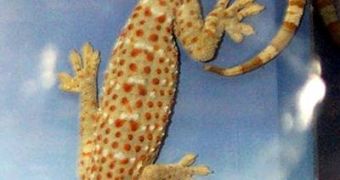Scientists and biologists around the world have been amazed at the small gecko's ability to climb virtually any surface since they first discovered the animal. From studying its feet, experts have inferred that materials making use of the same basic principles can be created, but exactly what triggers the grip and makes it turn “on,” and how this happens exactly have thus far eluded all scientific inquiries. Recently, scientists at the University of Calgary and Clemson University, in South Carolina, have managed to solve this long-standing puzzle.
In their investigation, they have determined that the only thing triggering a gecko's solid lock on objects is gravity, and not necessarily voluntary control from the animal itself. Details of the amazing find are currently published in today's online issue of the scientific journal Proceedings of the Royal Society B. In charge of the research were UC expert Anthony Russell and Clemson scientist Tim Higham. The new study represents the latest breakthroughs in gecko adhesive investigations, the team reports.
“Geckos use microscopic, hair-like filaments to attach to surfaces. Only at certain angles do they switch on their traction system, however. We are trying to understand this process, which will help in mimicking it for application to robotics,” Russell, who is a UC biological sciences professor, explains. “Much has been learned in recent years about the mechanism by which clinging takes place, but little is known about how geckos determine when to use this ability. We show that perception of body orientation determines when the adhesive system is switched on,” Higham, an assistant professor of biological sciences at Clemson, adds.
In their new study, the team have managed to determine that an inclination shift of as little as ten degrees is enough for the gecko to turn on its adhesive system. Out of the six geckos the team had to study, three turned on their feet at this angle change, while all six did so when the inclination shifted by 30 degrees. “There are costs, in terms of speed, and benefits, in terms of traction, associated with this switch just as there are for Formula 1 cars when rain tires are employed instead of slicks when circumstances place a premium on grip over outright speed,” Russell says.

 14 DAY TRIAL //
14 DAY TRIAL //